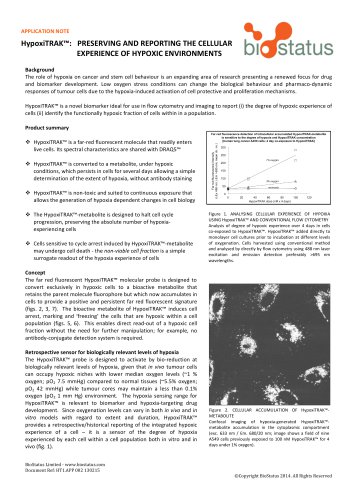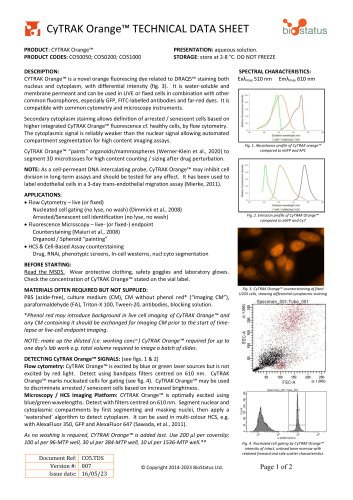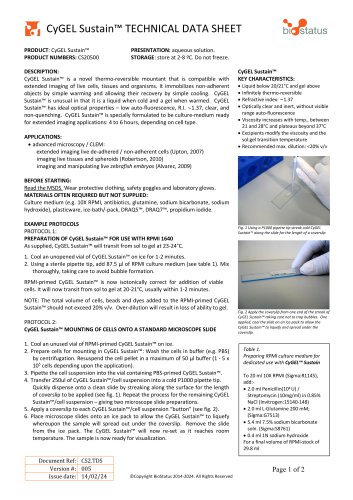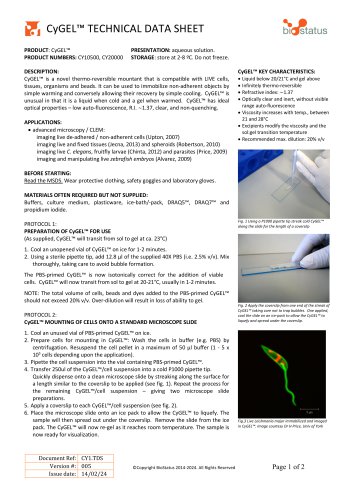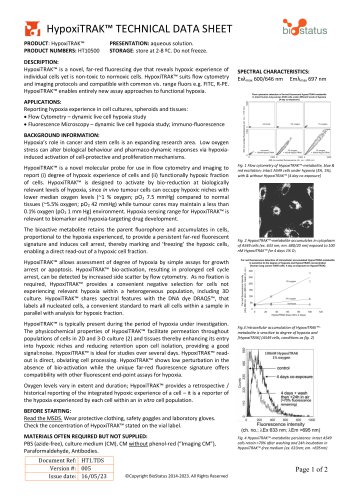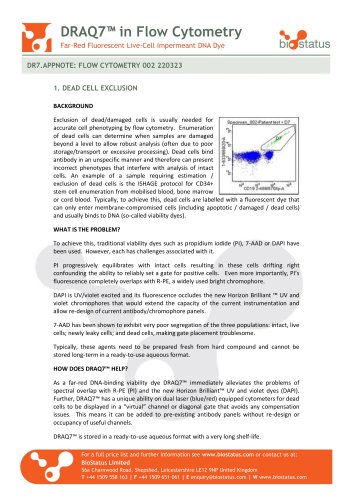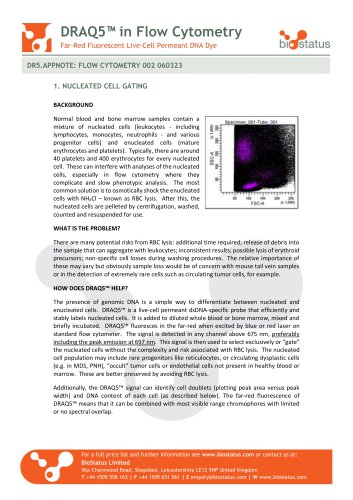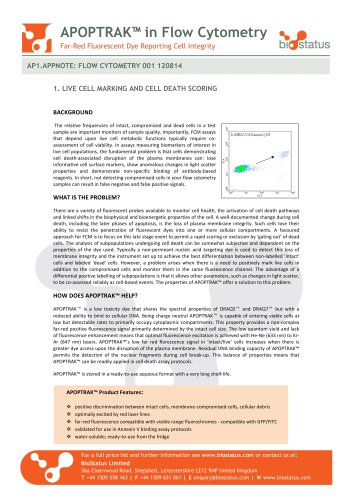
Catalog excerpts
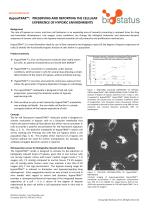
APPLICATION NOTE HypoxiTRAK™: PRESERVING AND REPORTING THE CELLULAR EXPERIENCE OF HYPOXIC ENVIRONMENTS Background The role of hypoxia on cancer and stem cell behaviour is an expanding area of research presenting a renewed focus for drug and biomarker development. Low oxygen stress conditions can change the biological behaviour and pharmaco-‐dynamic responses of tumour cells due to the hypoxia-‐induced activation of cell protective and proliferation mechanisms. HypoxiTRAK™ is a novel biomarker ideal for use in flow cytometry and imaging to report (i) the degree of hypoxic experience of cells (ii) identify the functionally hypoxic fraction of cells within in a population. Product summary v HypoxiTRAK™ is a far-‐red fluorescent molecule that readily enters live cells. Its spectral characteristics are shared with DRAQ5™ v HypoxiTRAK™ is converted to a metabolite, under hypoxic conditions, which persists in cells for several days allowing a simple determination of the extent of hypoxia, without antibody staining v HypoxiTRAK™ is non-‐toxic and suited to continuous exposure that allows the generation of hypoxia dependent changes in cell biology v The HypoxiTRAK™-‐metabolite is designed to halt cell cycle progression, preserving the absolute number of hypoxia-‐ experiencing cells v Cells sensitive to cycle arrest induced by HypoxiTRAK™-‐metabolite may undergo cell death -‐ the non-‐viable cell fraction is a simple surrogate readout of the hypoxia experience of cells Concept The far red fluorescent HypoxiTRAK™ molecular probe is designed to convert exclusively in hypoxic cells to a bioactive metabolite that retains the parent molecule fluorophore but which now accumulates in cells to provide a positive and persistent far red fluorescent signature (figs. 2, 3, 7). The bioactive metabolite of HypoxiTRAK™ induces cell arrest, marking and ‘freezing’ the cells that are hypoxic within a cell population (figs. 5, 6). This enables direct read-‐out of a hypoxic cell fraction without the need for further manipulation; for example, no antibody-‐conjugate detection system is required. Retrospective sensor for biologically relevant levels of hypoxia The HypoxiTRAK™ probe is designed to activate by bio-‐reduction at biologically relevant levels of hypoxia, given that in vivo tumour cells can occupy hypoxic niches with lower median oxygen levels (~1 % oxygen; pO2 7.5 mmHg) compared to normal tissues (~5.5% oxygen; pO2 42 mmHg) while tumour cores may maintain a less than 0.1% oxygen (pO2 1 mm Hg) environment. The hypoxia sensing range for HypoxiTRAK™ is relevant to biomarker and hypoxia-‐targeting drug development. Since oxygenation levels can vary in both in vivo and in vitro models with regard to extent and duration, HypoxiTRAK™ provides a retrospective/historical reporting of the integrated hypoxic experience of a cell – it is a sensor of the degree of hypoxia experienced by each cell within a cell population both in vitro and in vivo (fig. 1). Figure 1. ANALYSING CELLULAR EXPERIENCE OF HYPOXIA USING HypoxiTRAK™ AND CONVENTIONAL FLOW CYTOMETRY Analysis of degree of hypoxic experience over 4 days in cells co-‐exposed to HypoxiTRAK™. HypoxiTRAK™ added directly to monolayer cell cultures prior to incubation at different levels of oxygenation. Cells harvested using conventional method and analysed by directly by flow cytometry using 488 nm laser excitation and emission detection preferably >695 nm wavelengths.
Open the catalog to page 1
Exploiting HypoxiTRAK™ spectral properties HypoxiTRAK™ also provides a means of assessing the degree of hypoxia by simple assays for growth arrest or apoptosis. HypoxiTRAK™ bio-‐activation resulting in prolonged cell cycle arrest can be further detected by an increase in side scatter by flow cytometry. Since no fixation is required, HypoxiTRAK™ bio-‐activation can also provide a convenient method of negative selection for cells not experiencing significant levels of hypoxia within heterogeneous populations including 3D culture systems. HypoxiTRAK™ shares spectral characteristics with the...
Open the catalog to page 2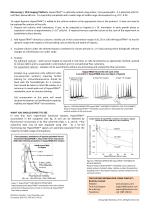
Microscopy / HCS Imaging Platform: HypoxiTRAK™ is optimally excited using yellow / red wavelengths. It is detected with far-‐ red filters above 660 nm. It is spectrally compatible with a wide range of visible range chromophores e.g. FITC, R-‐PE. To report hypoxia, HypoxiTRAK™ is added to the culture medium at the appropriate time in the protocol. It does not need to be replaced for analysis of the cells. 1. Prepare cell cultures with treatments, if any, to be subjected to hypoxia (t = 0): monolayer in early growth phase or 5 suspension culture at approximately 2 x 10 cells/ml. If required...
Open the catalog to page 3All BioStatus catalogs and technical brochures
-
CyGEL™ TECHNICAL DATA SHEET
2 Pages
-
DRAQ9™ TECHNICAL DATA SHEET
2 Pages
-
DRAQ7™ in Flow Cytometry
2 Pages
-
DRAQ5™ in Flow Cytometry
2 Pages
-
APOPTRAK™ in Flow Cytometry
1 Pages

